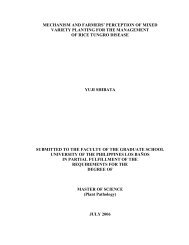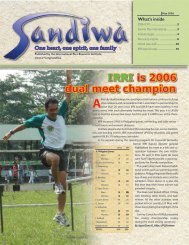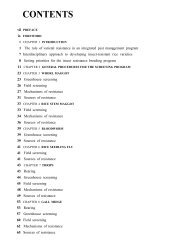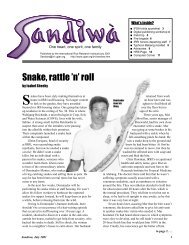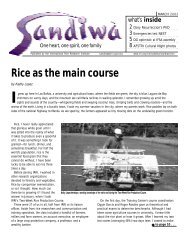Untitled - International Rice Research Institute
Untitled - International Rice Research Institute
Untitled - International Rice Research Institute
You also want an ePaper? Increase the reach of your titles
YUMPU automatically turns print PDFs into web optimized ePapers that Google loves.
Detection frequency (%)<br />
120<br />
100<br />
East Asia<br />
Europe<br />
Latin America<br />
South Asia<br />
Southeast Asia<br />
Sub-Saharan Africa<br />
80<br />
60<br />
40<br />
20<br />
0<br />
Detection level (%)<br />
100<br />
80<br />
60<br />
40<br />
20<br />
0<br />
1990 1991 1992 1993 1994 1995 1996 1997<br />
Year<br />
Fig. 39. Detection frequency (a) and level (b) of Curvularia sp. from imported untreated seeds, 1990-97.<br />
black conidial area with 3-mm sterile white margins.<br />
The colony on the reverse side of the agar plate appears<br />
zonated, black, and light outward. At 28 °C<br />
under alternating 12-h fluorescent light and 12-h<br />
darkness, colonies grow very fast and attain a 9.0-cm<br />
diam in 5 d. They are zonated, slightly cottony, and<br />
the conidial area is black with 5-mm sterile white<br />
margins turning black as conidia are produced. The<br />
colony on the reverse side of the agar plate appears<br />
slightly zonated, black, and light outward.<br />
Colonies on MEA at ART (28–30 °C) grow very<br />
fast and attain an 8.17-cm diam in 5 d. They are<br />
markedly zonated, felted, and greenish gray. The<br />
colony on the reverse side of the agar plate appears<br />
zonated and black. At 21 °C under alternating 12-h<br />
NUV light and 12-h darkness, colonies grow moderately<br />
fast and attain a 6.53-cm diam in 5 d. They are<br />
zonated, brown, and light outward. The colony on the<br />
reverse side of the agar plate appears zonated and<br />
brown, becoming lighter outward. At 28 °C under<br />
alternating 12-h fluorescent light and 12-h darkness,<br />
colonies grow very fast and attain an 8.23-cm diam<br />
in 5 d. They are zonated, slightly felted, olivaceous<br />
brown, and become light outward with 2-mm sterile<br />
white margins. The colony on the reverse side of the<br />
agar plate appears slightly zonated and black.<br />
40



